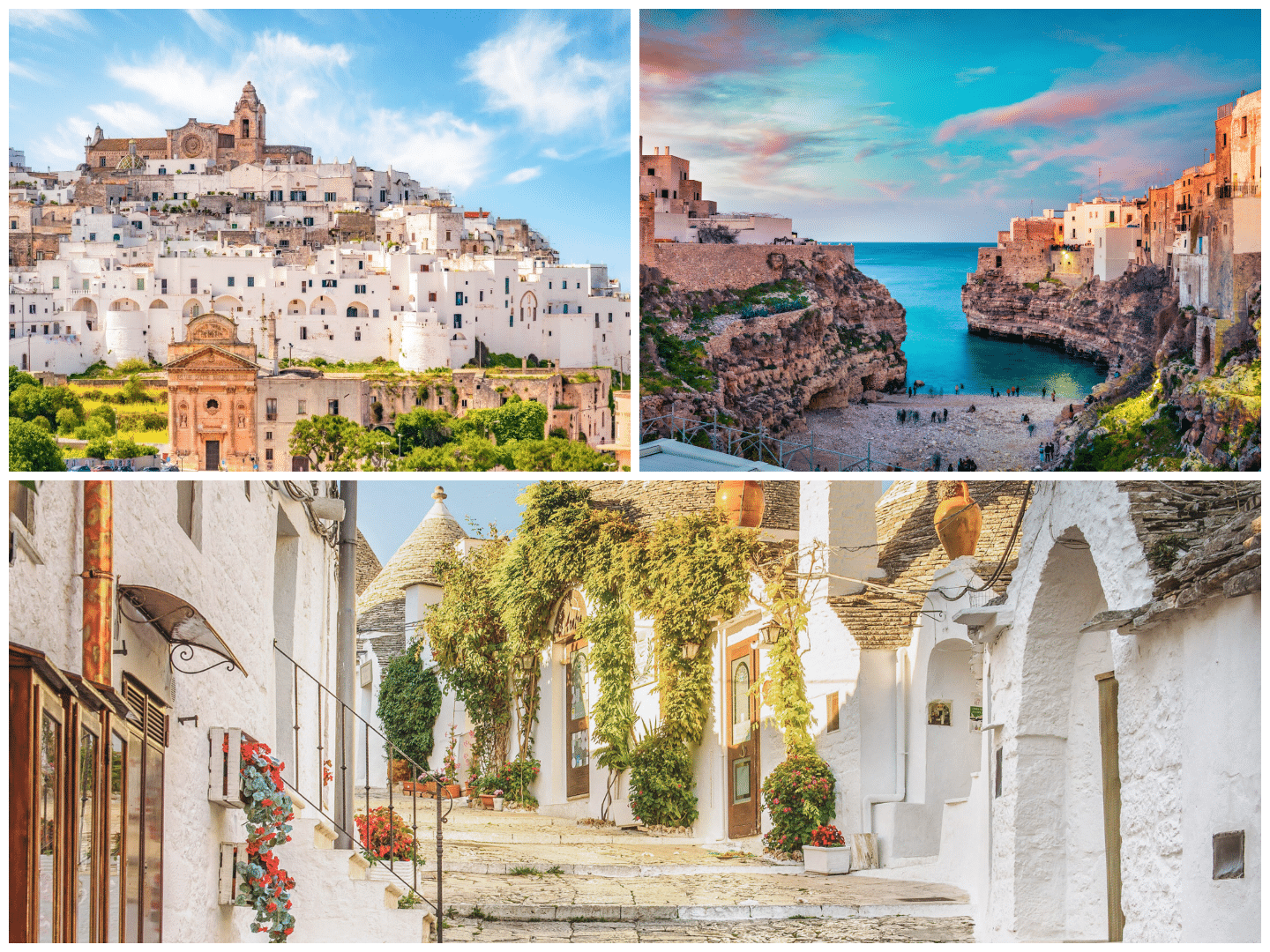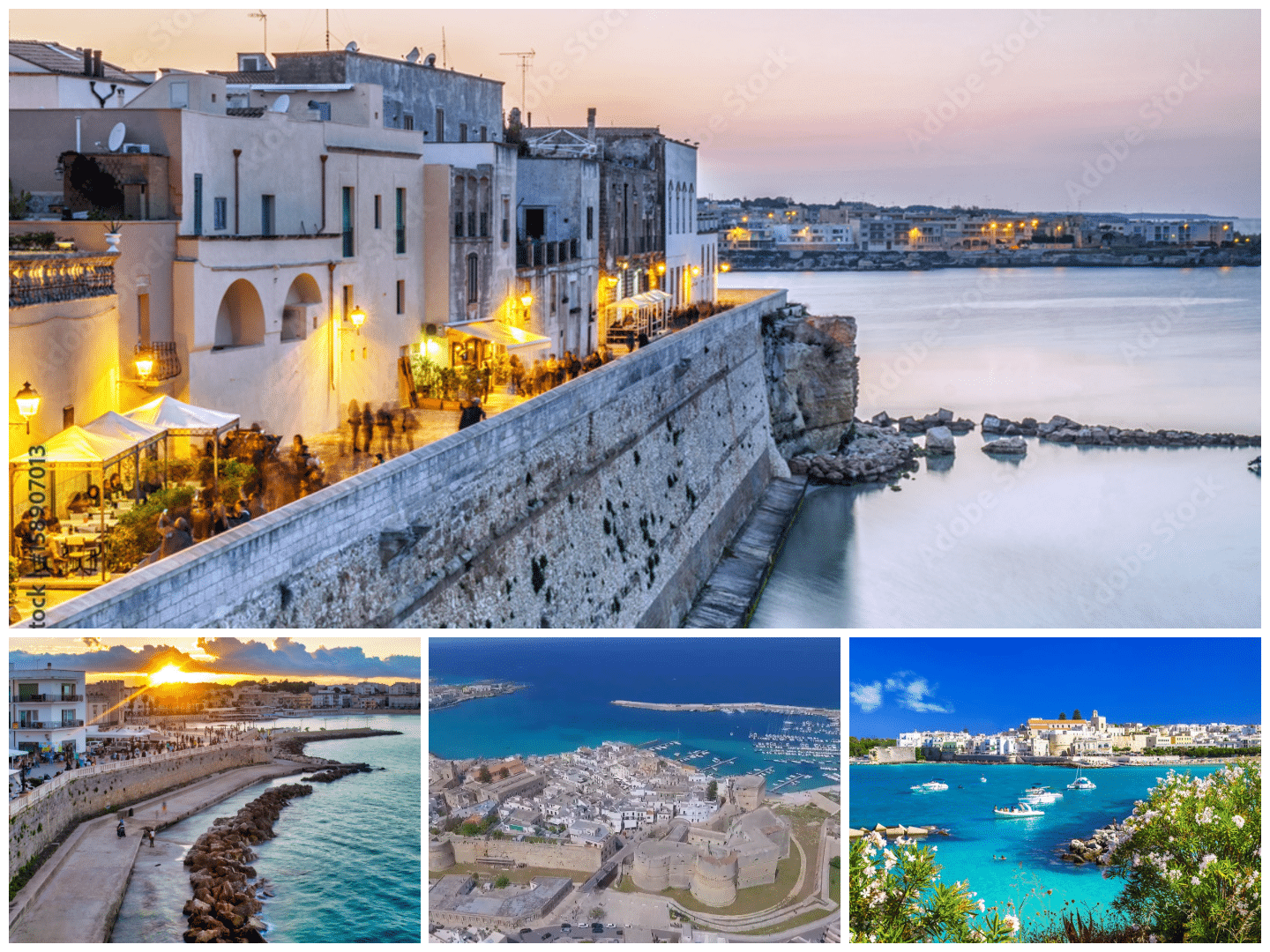This Apulia guide will discuss why you should visit this fascinating region. Furthermore, we’ll reveal some tips and tricks for traveling to this beautiful Italian region, undoubtedly one of the most enchanting. Many know it as the heel of Italy. Over there, you will find stunning scenery, welcoming beaches with the blue Caribbean Sea, tasty food, and thousands of years of culture and tradition. Last but not least, it offers excellent summer festivals and parties. You will undoubtedly fall in love with it once you spend a few days there.
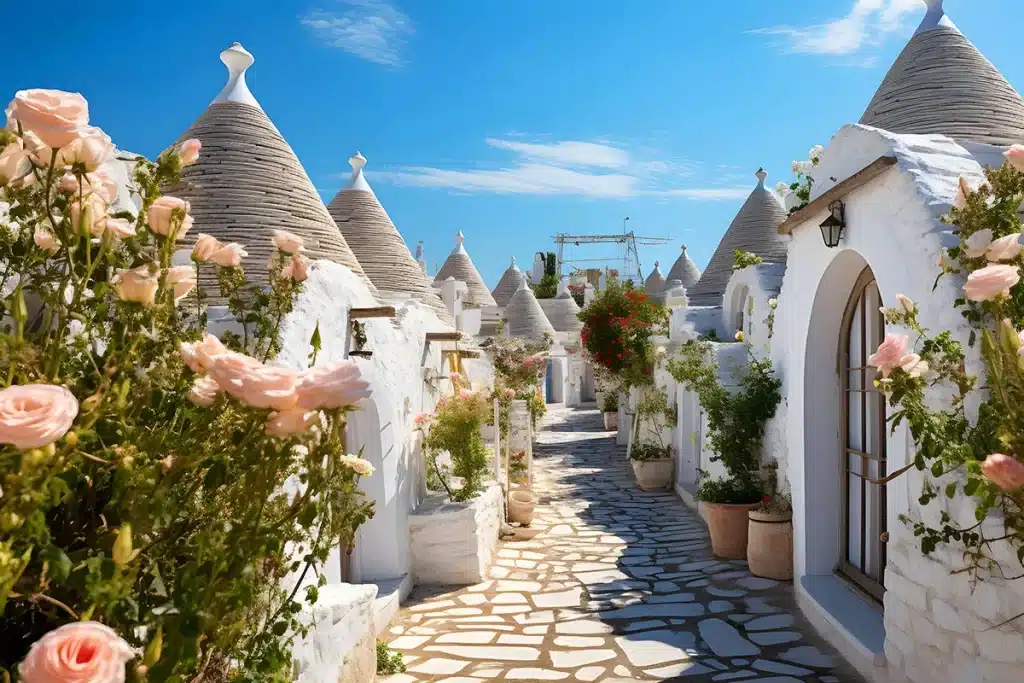
©hispanico.pl/Klaudia Komadowska
Our website includes affiliate links. So, remember that we may receive commissions when you click our links and make purchases. Please read our legal disclaimer document for more information about our Affiliate disclaimer and other disclaimers like the Fair-Use disclaimer.
Apulia Guide
Apulia, also known as Puglia in Italian, is a stunning region known for its picturesque landscapes, rich history, and delicious cuisine. Apulia is characterized by its charming coastal towns, historic architecture, olive groves, and beautiful beaches along the Adriatic and Ionian Seas. Let us give you a few ideas.
Where is Puglia?
Puglia, also known as Apulia, is a region in southern Italy. It forms the ‘heel’ of Italy’s boot-shaped peninsula. The Adriatic Sea borders it to the east, the Ionian Sea to the southeast, and the Gulf of Taranto to the south.
Important things to know before visiting Puglia, Italy
To fully experience Puglia’s offers, plan to explore its stunning beaches, historic cities, and charming towns for a few weeks. Puglia is known for its beautiful beaches, picturesque villages, and scenic countryside. It’s the perfect destination for a trip that combines beach relaxation with cultural exploration, delicious food and wine, and plenty of sunshine.
One refreshing aspect of visiting Puglia is the lack of “must-see” attractions. The region offers beautiful places, charming churches, good museums, natural parks, and excellent beaches, but few are considered essential sights. Puglia’s charm lies in relaxation, delicious food, and leisurely enjoyment. Historically overlooked, the region has seen a surge in tourism, leading to revitalization. Our advice? Visit now before it changes too much!
Ostuni – Charming whitewashed town in Salento
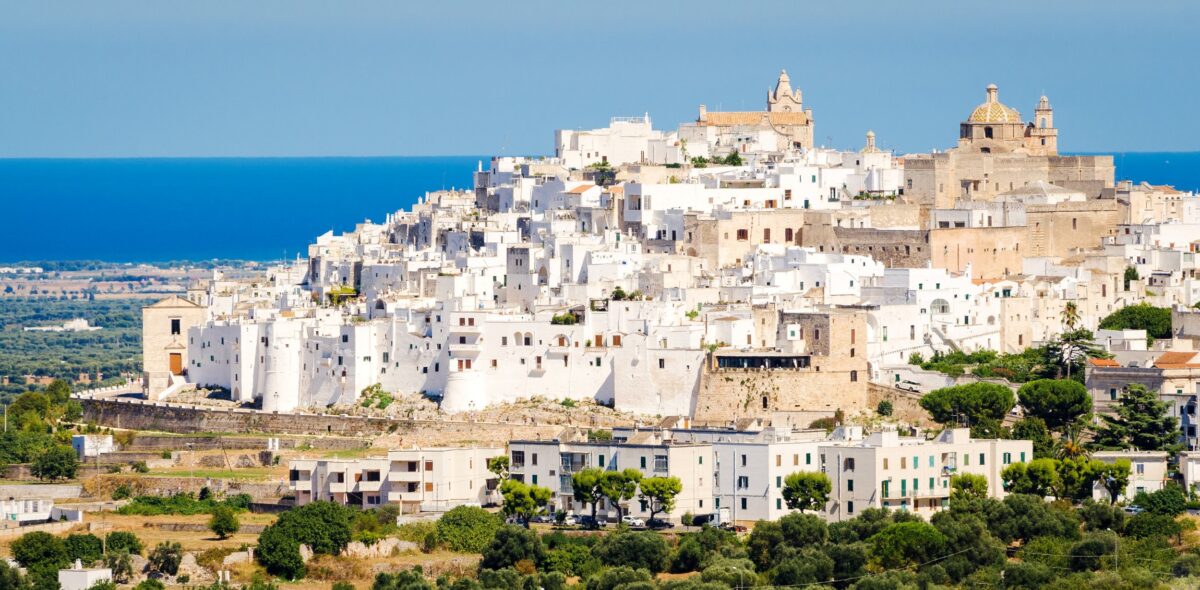
©Ostuni -istock-510266213
Matera – a stunning stone city

©iStock
What to See and Do in Apulia:
Puglia offers a diverse food culture, featuring dishes such as Orecchiette con Cime di Rapa and Burrata. Alberobello is known for its Trulli, while Castel del Monte is famous for its unique octagonal shape. The Salento Peninsula is home to charming towns and beautiful beaches. Polignano a Mare boasts a historic city center, and Gallipoli is a picturesque seaside town. Gravine di Puglia features rocks shaped by water erosion, reaching over 100 meters and resembling canyons.
- Alberobello: Visit this charming town’s unique trulli houses, a UNESCO World Heritage site.
- Matera: While technically in Basilicata, the ancient cave city of Matera is a short drive away and a must-visit.
- Lecce: Explore the “Florence of the South” with its stunning Baroque architecture.
- Ostuni: Wander through the “White City,” known for its whitewashed buildings.
- Locorotondo is regarded as one of the most beautiful Italian villages. Its whitewashed houses will conquer you.
- Gargano Peninsula: Discover this national park’s beautiful beaches, forests, and seaside towns.
- Castel del Monte: Admire the mysterious octagonal castle built by Emperor Frederick II.
- Bari: Explore the capital city of Apulia, a historic old town with a lively atmosphere.
- Food and Wine Tours: Taste the regional cuisine, including orecchiette pasta, olive oil, and local wines.
- Discover its beaches
- Discover its folklore
Orecchiette (Most Famous Puglia Food to Try)
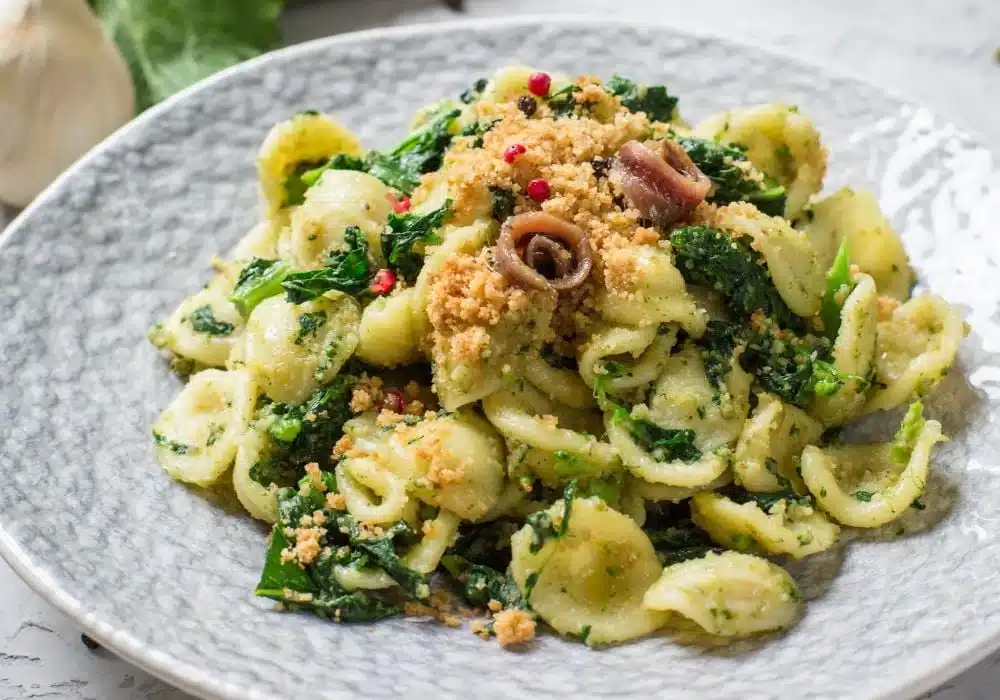
©goatsontheroad.com
What to Eat and Drink in Apulia:
Puglia has been predominantly an agricultural region for millennia, producing around 40% of Italy’s olive oil and a large proportion of its Wine. Vast tracts of the region’s territory are given over to farming, whether crops or livestock, and many inhabitants continue to grow their produce.
This essential agricultural nature means that the region’s cuisine is home-country inspired, predominantly using the abundant local produce such as durum wheat, tomatoes, artichokes, fava beans, rocket, courgettes, beans, fennel, peppers, onions, beef, and lamb.
- Orecchiette: A pasta shaped like small ears, often served with various sauces.
- Burrata: A creamy and delicious cheese, often served with fresh tomatoes and basil.
- Seafood: Apulia’s long coastline provides fresh seafood, including octopus, mussels, and sea urchins.
- Focaccia Barese: Try the local style of focaccia, typically topped with tomatoes and olives.
- Pasticciotto: A famous pastry filled with sweet custard or fruit jam.
Where to eat?
Whatever you want to eat, choose local “messier” (local farmhouses turned into villas and restaurants for tourists) or various Agritourism scattered throughout the countryside. The Agriturismo website has a vast selection of Agritourism.
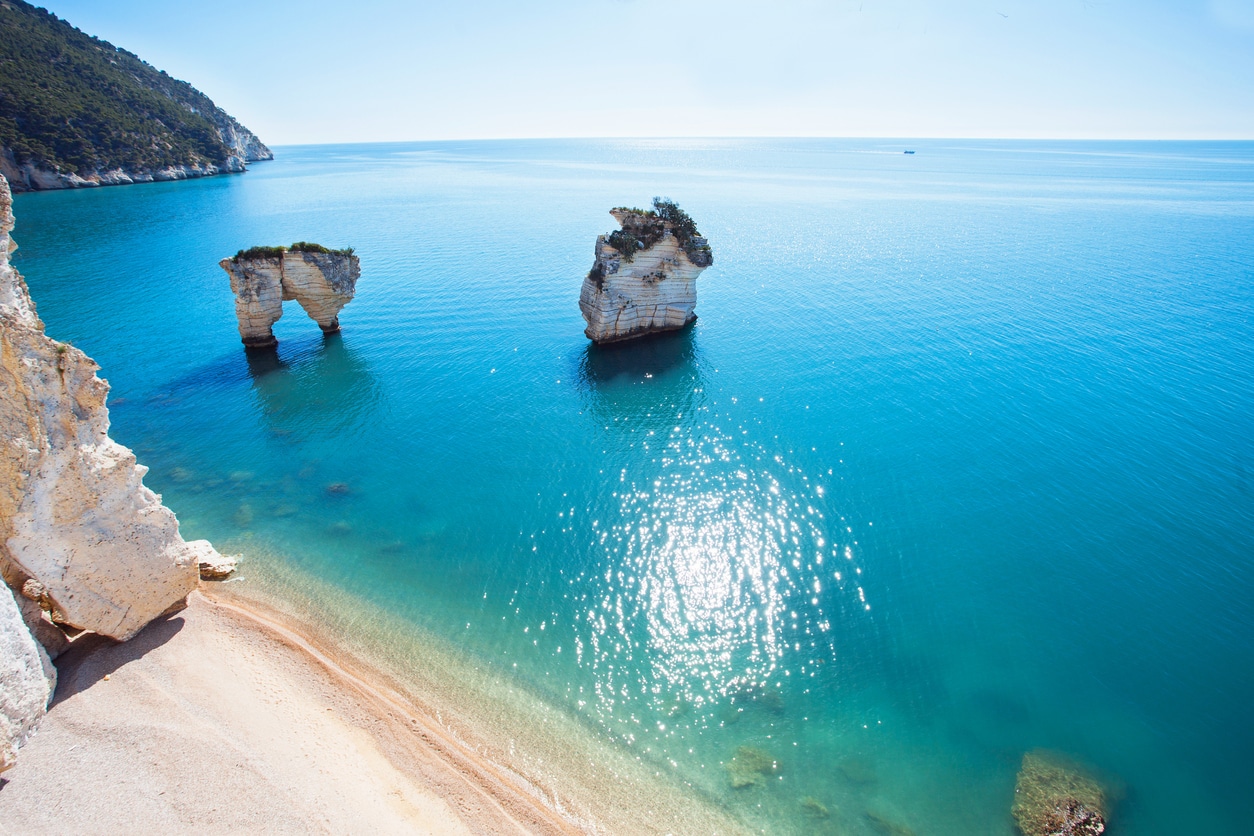
©Poike|
Credit: Getty Images/iStockphoto
Apulia Guide: Best Beaches
Finally, we arrived at the most desired part of our article: the shore of Apulia and its splendid small coastal towns and beautiful beaches. We believe the best beaches are in the Salento and Gargano regions, so we will focus only on the few selected beaches in these areas (we will give more details in a separate article).
What are the most popular beaches? Again, this is a complex question that doesn’t deserve an answer. There are so many of them, and all of them are beautiful. But then again, it all depends on your taste, whether you like more sandy beaches, beaches with excellent facilities, or more secluded beaches. Therefore, we have chosen only a few.
Let’s go and check them out, all right?
- Polignano a Mare: Famous for its cliffside beach and crystal-clear waters.
- Gallipoli: Offers sandy beaches and a charming old town.
- Porto Cesareo: Known for its Caribbean-like beaches and marine reserve.
- Torre dell’Orso: Features stunning limestone cliffs and turquoise waters.
- Pescoluse (Maldive del Salento): Known for its vast sandy shores.
Puglia’s folk dances
Puglia has a few thousand years of traditions so we could write about them; however, we will focus only on two dances, which we think you should see. The first is Tarantella. This group of folk dances is characterized by a fast-paced tempo, usually with two, four, or more dancers accompanied by tambourines. It is one of the most recognized traditional music forms from southern Italy.
In the Italian province of Taranto, Apulia, the bite of a spider named “tarantula” after the region was popularly believed to be highly venomous and to lead to a hysterical condition known as tarantism. This became known as the Tarantella. R. Lowe Thompson proposed that the dance is a survival of a “Dionysiac cult.”
The specific dance name varies with every region, and in Puglia, the dance has evolved into a new form called Pizzica, the most popular dance in Puglia in the past thirty years. Since 1998, there has been a Notte della Taranta (Tarantula night), consisting of an entire night where many famous musicians alternate their performances with pizzica orchestras.
Notte della Taranta 2020 – PIZZICA
Discover Puglia’s Vibrant Nightlife
In Aoukua, you can experience exciting nightlife in the major cities of Bari, Taranto, and Foggia. However, if you’re here for a holiday, we highly recommend exploring the Salento peninsula – the southernmost part of Italy’s heel. The capital, Gallipoli, boasts a lively “Centro Storico” surrounded by stunning sandy beaches.
That’s why it is fast becoming a top summer destination in Italy, especially among young people. During the summer, you can enjoy beach parties, concerts, international DJs, and more. The fun never stops, day or night!
Must-visit party spots include Samsara Beach, Lido Zen Beach, Zeus Beach, and Praja Gallipoli. But since clubs and discos may change yearly, we suggest asking locals for recommendations.
Apulia also offers a welcoming environment for the LGBTQ community, making it one of Italy’s most inclusive regions.
Note: Check out our Gay Gallipolli article for more information.
Getting there:
EasyJet and Ryanair fly to Bari from London Gatwick and Stansted. Ryanair also flies to Brindisi from Stansted and operates summer flights from Manchester. Both airports are only 1.5 hours’ driving distance from each other.
The best way to get to Puglia from Rome is by taking a direct high-speed train to Bari Centrale, which takes approximately 4 hours without a connection. Alternatively, you can take a bus.
Puglia has two international airports, Bari and Brindisi, just an hour apart. They have connections to cities all over Italy and many European capitals.
High-speed trains from Rome connect with Bari, Brindisi, and Lecce. All trains headed to Brindisi and Lecce will first pass through Bari.
By car, it takes under 5 hours to reach Rome and 3 hours to reach Naples, with good road conditions.
Note: If you’d like to arrive in Apulia by train, we suggest using Omio. If you’d like to fly to Puglia, we recommend using Sky Scanner. However, if you are arriving there by ferry, we recommend using a Ferry Scanner.
How to get around
When visiting Puglia, renting a car is the best way to explore the region, providing freedom and flexibility. Public transportation, such as trains and buses, is available but may have limited schedules and potential delays, especially when traveling to smaller areas. Walking and cycling are good options for navigating cities and experiencing the region leisurely. However, accessibility accommodations may not be consistently available. Car renting is the most effective way to explore Puglia, despite potential challenges such as road conditions and limited-traffic zones in cities and villages.
By train
The train service in Puglia is better than in Italy’s central and eastern regions. There are train connections between the main cities of Bari, Brindisi, and Lecce, but very few smaller towns have train stations, and most smaller cities do not have train services. The Bari metropolitan region is the only area with reliable train service outside the main cities. The train connections are good there, and you can easily visit nearby medium-sized cities with regular schedules.
By Bus
Puglia’s transportation network could be more helpful for tourists. Most routes only connect regional hubs with the larger nearby towns, leaving small towns, the countryside, beaches, and other places inaccessible. Even where bus routes exist, the service is intermittent and unreliable, and travel times are long, often involving a change. Furthermore, many bus routes only operate in the summer, ceasing service from May to mid-September.
By car
When visiting Puglia, having a car is essential for road trips and exploring the countryside and coast. The main highways are in good condition, and driving is easy. Parking is usually acceptable; you can park at the edge of town and walk into the center. I advise against dining in Bari, but driving in Lecce is excellent if you avoid the no-traffic zones.
Where to find a car rental
When renting a car, you’ll find varying prices and conditions among different companies. Bari and Brindisi are the most accessible places, while Lecce has fewer options. I recommend using DiscoverCars to check prices and make a booking, as it offers options from major international rental companies and smaller local agencies with competitive pricing.
Renting a car
Many companies have varying prices and car conditions when you rent a car. You’ll find all your international companies here and a host of smaller, locally-owned ones.
The most accessible places to rent a car are Bari and Brindisi. Lecce has some selections, but most rental agencies are also available because the airports are in Bari and Brindisi.
To check prices and book, I recommend using DiscoverCars. It’s a car rental site with offerings from major international rental companies and many smaller local agencies, which often have much better pricing. You can frequently find great deals.
Road conditions in Puglia
When driving in Italy’s Puglia region, you will encounter various types of roads. The main dual motorway along the east coast is busy and requires drivers to yield to oncoming traffic. The countryside roads offer a more peaceful driving experience. The Gargano Peninsula has windier and steeper roads than other parts of Puglia.
Here’s a breakdown of the types of roads you will come across while exploring Puglia:
Autostrada: These highways are generally in excellent condition, well-maintained, and equipped with explicit signage, rest stops, and service areas.
Strade Statali (SS) (State Roads): These roads connect significant towns and cities within Puglia and other regions. They’re generally well-maintained and offer a good balance between higher speed and scenic drive.
Are there toll roads in Puglia?
In Puglia, there are two toll roads: Autostrada A14 Bologna-Taranto and Autostrada A16 Napoli-Canosa. Verify toll roads on Google Maps using the coin avatar. It costs approximately 8 EUR for 100 km from Bari to Taranto and 10 EUR for 135 km from Bari to Foggia. Consider using SS or SP roads if you’re not in a rush. Carry cash for tolls, but card payment is usually accepted. Avoid the Telepass lane if you don’t have a pass.
One-way alleyways and ZTL zones
When driving into the old towns of Puglia, it’s essential to be mindful of where you park. It’s best to find parking at the edge of the historic center (Centro Storico) to avoid accidentally entering a ZTL zone. ZTL zones are limited-traffic areas monitored by cameras, and entering them without a permit can result in a fine. These zones are designed to limit traffic and pollution within historic centers, and only residents typically have permits to drive in these areas.
Additionally, navigating these old towns’ narrow, one-way streets can be complex and confusing. Therefore, it’s advisable to park at the edge of the historic village and explore on foot to avoid any driving complications.
Parking in Apulia
When driving in Puglia, Italy, consider renting a small car due to narrow roads and tight parking spaces. During the high season, traffic can get busy in the Itria Valley and coastal areas. Be cautious of car break-ins, especially in Puglia. Use Google Maps to locate accessible parking spots marked with white lines when parking. Avoid parking in reserved areas marked with yellow lines to prevent fines or towing. Consider using the EasyPark App to make parking payments.
Best time to visit Puglia
Puglia is hot and busy during high summer in July and August, with prices inflated and temperatures reaching the mid-30°Cs. May, June, and September offer lovely weather for outdoor activities. April and October are good months to visit but expect some rain and chilly days. From November to March, temperatures are more relaxed, and there’s less tourist activity. Before and after the central summer months, the region experiences mild weather, making it ideal for a peaceful visit. This is also a great time to explore the countryside and taste the region’s wine and olive oil. So, to sum it up together, we recommend visiting Apullia during the shoulder season (May, June, and September).
How long should you stay there?
Seven to ten days is a minimum stay for this region. In that case, you can cover Bari, Matera, a little of the Valle d’Itria, Monopoli, Polignano, Lecce, and some of the Salento peninsula. With a whole week, you can see Bari, spend a night in Matera, explore the Valle d’Itria, and visit the highlights of Lecce and the Salento coast. The ideal time for a visit is 10-14 days, allowing you to see significant towns and cities, get off the beaten path, and hit the beach without rushing. If you only have a weekend, you can start in Bari, visit Castel del Monte, spend the night in Valle d’Itria, and then visit Alberobello and a coastal city like Polignano a Mare or Monopoli the following day. If you have 14 days, you can add lesser-visited places such as Trani, Putignano, Martina Franca, Gallipoli, and the Gargano peninsula. Some must-visit places are Bari, Polignano a Mare, Ostuni, Alberobello, Lecce, Otranto, and Matera.
Where to stay
When visiting Puglia, consider basing yourself in a small town or the countryside. More importantly, renting a car in Puglia provides the freedom to choose authentic and unique accommodations in the countryside, such as trulli or masserie. Furthermore, Puglia offers beautiful towns and cities, fabulous beaches, and unspoiled nature. Consequently, many experts and travel nomads recommend choosing at least three places, ideally in a town, the countryside, or the beach.
For a week-long stay, consider a road trip with four different bases – Bari, Matera, a town in the Valle d’Itria, and a city in the Salento peninsula. If you prefer to move less, choose two bases (the Valle d’Itria and Salento peninsula) and do day trips from them.
The Valle d’Itria is an excellent choice for charming countryside and cute towns. Lecce and Bari are enjoyable metropolitan areas for urban exploration, art, and culture. Consider the Savelettri, Gallipoli, and Otranto areas if you prefer sandy beaches.
Puglia is relatively expensive, especially during the summer. To save on hotels, consider staying in the countryside or booking outside significant platforms. Food prices are reasonable, and car rentals typically cost 20-50 euros daily.
Tip: Accommodations are cheaper the farther away from the beach. Being just five kilometers from the shore can make a noticeable price difference. Consider towns like Otranto and Melendugno for more budget-friendly options.
Apulia guide: Tips
When planning your vacation in Puglia, your preferences will determine what you should look for and where to visit. We recommend staying for at least a week. If we had to suggest places not to miss, we would recommend Ostuni, Alberobello, Pogliano a Mare, and the beaches of the Salento peninsula.
- Renting a car is highly recommended. You can rent one at the airport, hotel, or car rental services, or ask the friendly locals for assistance.
- While many tour operators offer excursions around Apulia, we advise against taking their offers. Instead, book your trip at a local agency to save money.
- The best time to visit is between April and July when nature is most beautiful and there are fewer crowds. Avoid staying in August during Ferragosto, as prices skyrocket and there are too many tourists.
- In terms of safety, Puglia is generally safe, but pickpocketing is a concern. As a tourist, it’s best to avoid dark and empty places and to stay vigilant.
- If you have any further questions, feel free to check out our FAQ or leave a comment. We’d love to hear about your favorite places in Puglia and any suggestions you may have.
Apulia Guide: FAQs
How long should I stay in Apulia?
Taking a week for your Italian road trip is a great idea, but it’s even better if you have more time, as you can unwind and enjoy the sunny weather. Remember to arrange for car rental (check out transportation options), secure travel insurance, and select two or three locations to stay at as your home bases during the trip.
The best places to stay in Apulia
When planning your Italian road trip, consider staying in one of Puglia’s beautiful and safe towns: Bari, Polignano, Monopoli, Alberobello, Ostuni, Lecce, and Vieste. Selecting two or three of these locations as your home base is best. Bari is an excellent option for first-time visitors to the region, as it is one of the gateways to Puglia and Brindisi.
Do I need additional medical insurance for travel to Italy?
The answer is yes. We strongly advise you. You will save a lot of time in case of an emergency.
How much money do I need in Puglia?
Puglia is a picturesque region on the “heel of Italy” with charming Italian villages, nature reserves, beaches, and caves. It offers a good-value destination with high-quality, reasonably priced food and drinks. The estimated daily expense is €100, but enjoying the affordable food and beaches can make it a budget-friendly trip.
Combining Puglia with other destinations
You can easily combine a visit to Puglia with other top destinations in Italy, such as the Amalfi Coast, Tuscany, Sicily, Rome, Florence, and Venice.
Take a look at
References and sources:
- Locorotondo/Lonely Planet
- Locorotondo/Italy Magazine
- Never Ending Voyage
- Wikipedia/Ostuni
- The 10 Prettiest towns in Puglia/CN Traveler
- The Thinking Traveler
- Salento.com
- Viaggia nel Salento
- Expedia/Marina di Pescoluse
- Charming Puglia
- Aria Journeys
- Nomad is beautiful
- Neverending Voyage
- Great Italian Chefs/Puglia Food Guide
- Italian Breaks/Food and Drink in Puglia
- Wikipedia/Tarantella

